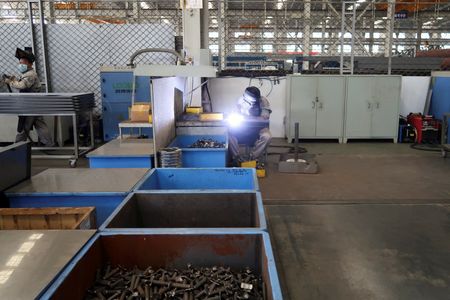
BEIJING (Reuters) – China’s factory activity extended declines in August as new COVID infections, the worst heatwaves in decades and an embattled property sector weighed on production, a survey showed on Wednesday.
The official manufacturing purchasing managers’ Index (PMI) rose to 49.4 in August from 49.0 in July, the National Bureau of Statistics (NBS) said. The index remained below the 50-point mark that separates contraction from growth but was higher than the 49.2 expected in a Reuters poll of analysts.
The sub-index for new orders grew by 0.7 point, while the employment sub-index edged up by 0.3 point. But the sub-index for supplier delivery times dropped by 0.6 point amid new COVID cases.
The survey suggests little improvement in the world’s second-biggest economy in August activity, after a rebound in June following the reopening of COVID lockdowns.
Amid tighter COVID restrictions in August from July, analysts say there are few signs Beijing plans to ease its zero-COVID policy.
According to Nomura, 28 cities – accounting for 15.7% of China’s GDP – were under full or partial lockdowns or anti-virus curbs as of Monday.
The extreme heat and drought also caused some regions such as the southwestern province of Sichuan and neighbouring Chongqing to suspend industrial production to ensure residential power supply, disrupting operations of well-known manufacturers like Taiwan’s Foxconn and battery giant CATL.
Some construction work was also suspended due to the heat, dragging down the official non-manufacturing PMI in August to 52.6 from 53.8 in July.
The official composite PMI, which combines manufacturing and services, fell to 51.7 from 52.5 a month prior.
China’s economy slowed sharply in the second quarter as widespread COVID-19 lockdowns hammered demand and business activity, while the property market has lurched from crisis to crisis.
To revive the economy, the central government last week offered another stimulus package, raising the quota on policy financing tools by 300 billion yuan ($43.37 billion).
The central bank also cut benchmark lending rates and lowered the mortgage reference by a bigger margin.
But headwinds remain as youth unemployment climbs to a record high while rising domestic consumer inflation weighed on further policy easing steps.
Economists also warn of weakening external demand that may hinder China’s exports, which shored up growth in the first half of the year, making up for sluggish consumption.
($1 = 6.9177 Chinese yuan)
(Reporting by Ellen Zhang and Ryan Woo; Editing by Sam Holmes)

